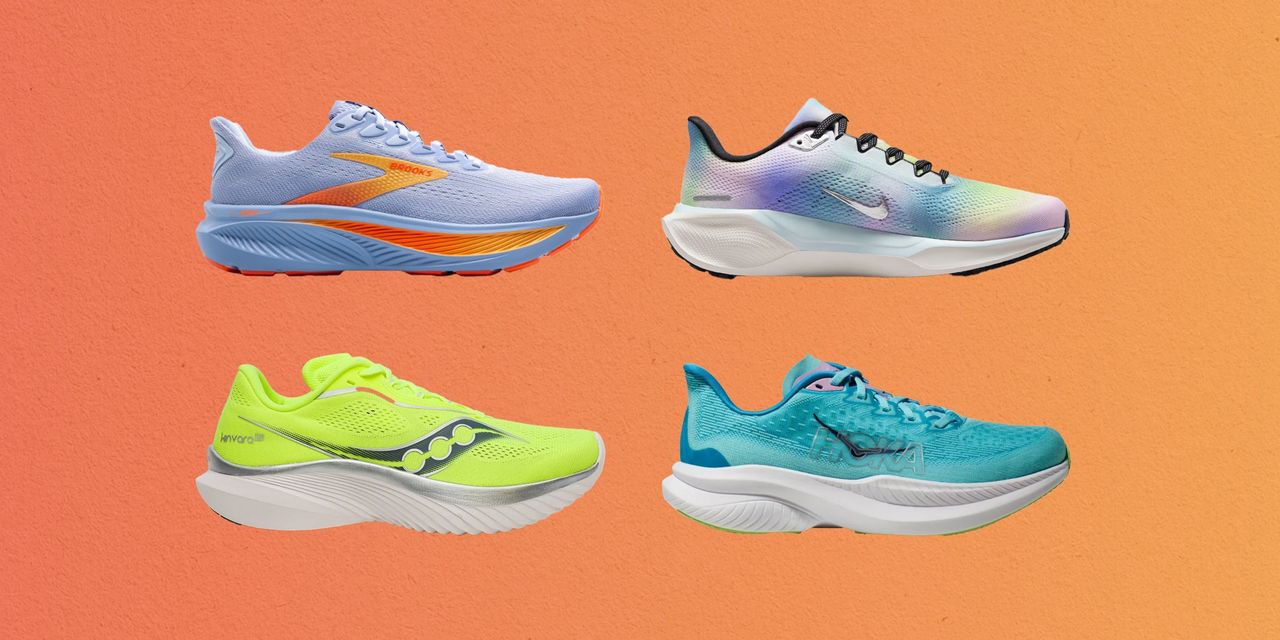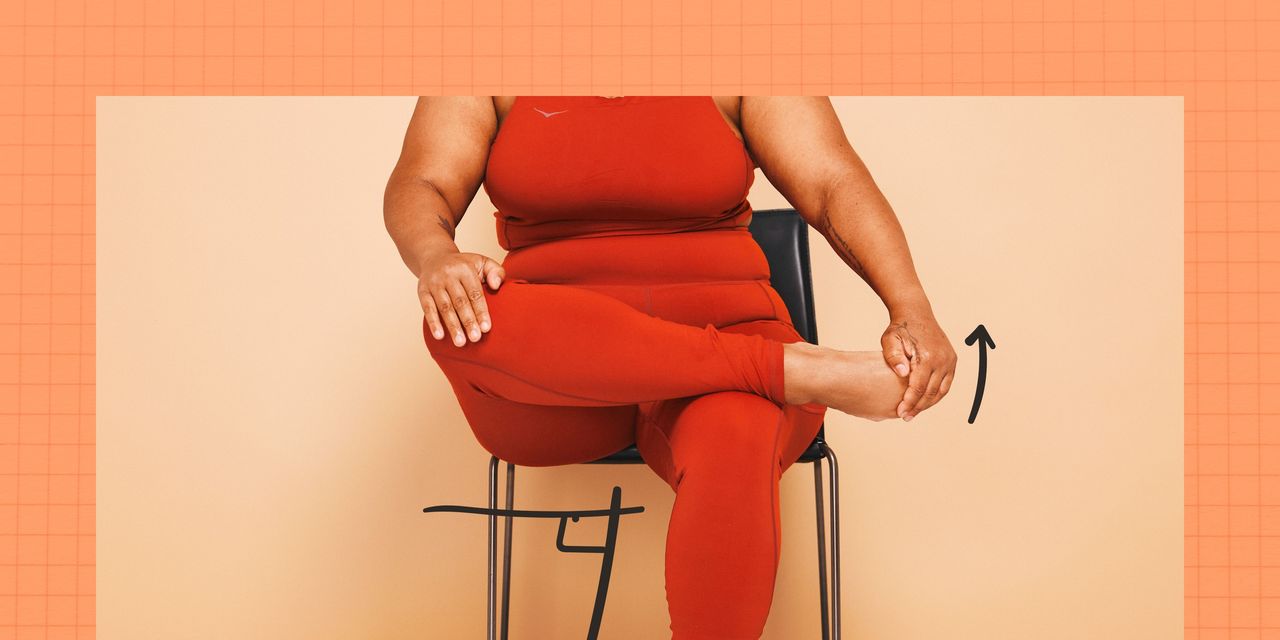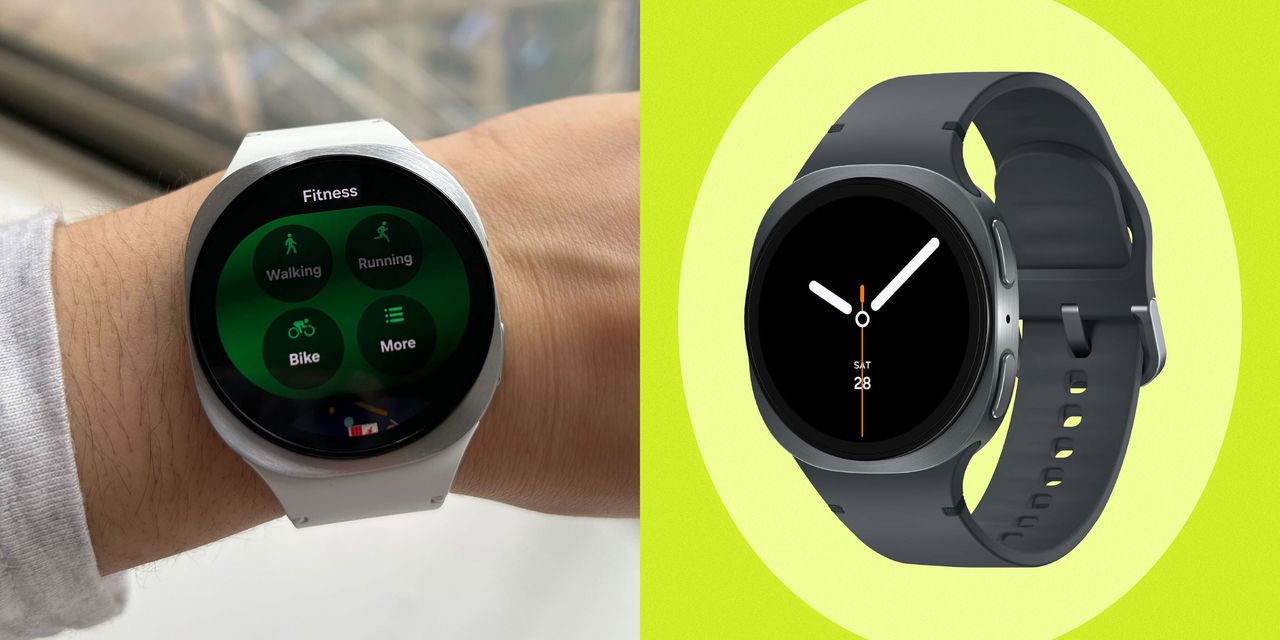The Best Treadmill Running Shoes That Won’t Wreck Your Knees

All products featured on Self are independently selected by our editors. However, we may receive compensation from retailers and/or from purchases of products through these links.
Love it or hate it, the treadmill is part of life when you’re a runner. Whether the weather is unpleasant or you need to squeeze in a few miles while keeping an eye on a kid or a Netflix show, odds are that you’ll log some indoor miles occasionally. But when the tread calls, will your road running sneakers cut it?
The best treadmill shoes have major benefits over your daily trainers. “The treadmill has all of that shock absorption built-in, so a lot of runners don’t need the max-cushion shoes that feel nice outside,” certified running coach Amanda Brooks tells SELF. They should also have super breathable uppers, since “there’s a lot of sweat being generated in one place that’s dripping below you,” Nick Krouse, director of footwear at Fleet Feet, tells SELF.
In the market for shoes that’ll play nice with your treadmill workouts? We asked the experts for their top picks—plus logged some indoor miles of our own—to find our favorites.
Our top picks
- Best Overall: Hoka Mach 6, $140
- Best for Beginners: Brooks Ghost 17, $150
- Best for Overpronators: Asics Gel-Kayano 31, $165
- Best for Wide Feet: New Balance Fresh Foam X 880v15, $140
- Best Max Cushion: On Cloudmonster 2, $150
- Best Daily Trainer: Nike Pegasus 41, $140
- Best Lightweight: Saucony Kinvara 15, $120
- Best Carbon-Plated: Puma Deviate Nitro 3, $160
These pairs will give your current kicks a run for their money.
Best Overall: Hoka Mach 6
If you think all Hokas are chunky shoes with lots of foam, think again. The Mach 6 has a more moderate stack of bouncy, supercritical foam than classic Hokas, like the Clifton or Bondi—exactly what you want for treadmill running, says Krouse.
Brooks likes the Mach 6 for uptempo work on the tread, like intervals. Deitz adds that its lower stack is ideal for classes where you’ll be on and off the tread (like Orangetheory).
I’ve loved the Hoka Mach for years, through miles of all paces and countless Barry’s classes. So, when I tested the latest model, I was unsurprised that it felt amazing underfoot. Another pro: Unlike last year’s version, the 6 also has a super durable rubber outsole that’ll last for tons of workouts.
Sizes: US 5 to 11 | Material: Creel jacquard, foam, rubber | Widths: Regular, wide | Weight: 6.7 oz | Heel drop: 5 millimeters
Best for Beginners: Brooks Ghost 17
The Brooks Ghost is one of the best beginner running shoes out there—it’s dependable, comfortable, stable, and not too pricey. It also has all the makings of a great treadmill shoe, says Laura Summeril, product manager at Road Runner Sports, like a moderate stack of responsive (but firm) foam.
“It’s going to work great inside and outside,” says Brooks. “It works for a lot of people, so it’s definitely a go-to option.” One reason why: It comes in four widths, so even if you run on the narrow or wide side, odds are there’s a Ghost that’ll work for you.
Sizes: US 5 to 13 | Material: Mesh, foam, rubber | Widths: Narrow, medium, wide, extra-wide | Weight: 9 oz | Heel drop: 10 millimeters
Best for Overpronators: Asics Gel-Kayano 31
If you wear a stability shoe on the roads, you’ll want to get a pair with similar levels of support for the tread. These pairs are designed for runners who overpronate (meaning your feet and ankles roll inward when you land). They have more support on the sides to keep your gait neutral and to help your soles wear out more evenly.
Brooks’ pick for a treadmill stability shoe is the Gel-Kayano 31. She loves its moderate cushioning—which she says is harder to find in stability shoes these days—and great arch support. One drawback: The Gel-Kayano doesn’t have as breathable an upper as some other shoes on this list do (so, if sweaty feet are a consideration, you may want to skip this one).
Sizes: US 5 to 13 | Material: Mesh, foam, rubber | Widths: Narrow, regular, wide | Weight: 9.4 oz | Heel drop: 10 millimeters
Best for Wide Feet: New Balance Fresh Foam X 880v15
New Balance
Fresh Foam X 880v15
The 880v15 is a classic, beloved daily trainer with plenty of treadmill-friendly features, says Summeril. Two to note? Its comfortable, but not too plush ride and just-firm-enough foam. It’s also known as one of the best daily trainers on the market for runners with wide feet. If the generous toe box in the standard width isn’t enough, the 880 also comes in wide and extra-wide widths.
Sizes: US 5 to 12 | Material: Mesh, foam, rubber | Widths: Narrow, standard, wide, extra-wide | Weight: 8.4 oz | Heel drop: 6 millimeters
Best Max Cushion: On Cloudmonster 2
While a max cushion shoe can be redundant (or even uncomfortable) on the tread, you may be a max-cushion-or-bust runner—and that’s okay. In that case, opt for a treadmill shoe that has a firmer foam, for more stability and responsiveness.
That’s where Dr. Sierra’s favorite, the On Cloudmonster 2, comes in. “The foam they use is awesome, it’s really responsive,” he says. “When added with the treadmill, it’s even better. I feel like I’m getting good feedback with it, and I’m less tired and sore the next day.” Just know that, with all that cushion, it’s pretty heavy: At 8.8 ounces, it’s one of the heftier shoes on this list.
Sizes: US 5 to 11 | Material: Recycled polyester mesh, foam, nylon-blend speedboard, rubber | Widths: Standard | Weight: 8.8 oz | Heel drop: 6 millimeters
Best Daily Trainer: Nike Pegasus 41
There isn’t much you can throw at the Nike Pegasus that it can’t handle. And, as one of Brooks’ favorites for the treadmill, you can include indoor running on that list too.
I love the Pegasus for runs of all kinds—even those with double-digit mileage, thanks to the Air Zoom units in the midsole that provide extra shock absorption and support. It’s also one of Deitz’s top picks for gym sessions or classes when you’ll be on and off the tread (talk about a true workhorse).
Sizes: US 5 to 12 | Material: Mesh, foam, rubber | Widths: Regular, extra-wide | Weight: 8.8 oz | Heel drop: 10 millimeters
Best Lightweight: Saucony Kinvara 15
“A lot of people feel slower on the treadmill, so having a shoe that’s a little lighter and a little snappier can be nice,” says Brooks. Her shoe of choice is the Saucony Kinvara 15, which, at 6.2 ounces, is as light as daily trainers get.
“I like that it doesn’t have a big stack height, and I like the low heel drop on it—for a lot of people, a lower heel drop is going to help prevent knee pain,” she adds. (FYI: She’s talking about heel-to-toe drop, or the difference in height between the shoe’s forefoot and heel, in millimeters.)
With the Kinvara, you’ll be lower to the ground than in most other sneakers, making it another go-to option if you need a running shoe that can also perform during a HIIT workout or strength training session.
Sizes: US 5 to 12 | Material: Mesh, foam, carbon rubber | Widths: Regular, wide | Weight: 6.2 oz | Heel drop: 4 millimeters
Best Carbon-Plated: Puma Deviate Nitro 3
Many runners opt for super shoes for races and fast workouts—they have a carbon plate for propulsion and a high stack of foam. But super shoes aren’t ideal for the treadmill because all that foam can be unstable, and they tend to wear out quickly.
For the speedy boost of a carbon plate in a more treadmill-friendly package, Brooks recommends the Puma Deviate Nitro 3. It has a lower stack of foam, a more durable outsole, and a lower price point than a true super shoe.
When my pair of Deviate Nitro 3s arrived for testing, it was love at first mile—they have a smooth, springy ride that feels effortlessly speedy on the tread. Plus, the carbon plate isn’t so aggressive that you can’t wear them for more downtempo runs too.
Sizes: US 5.5 to 11 | Material: Mesh, foam, carbon plate, rubber | Widths: Regular | Weight: 8.8 oz | Heel drop: 10 millimeters
Best for Speedwork: Adidas Adizero Evo SL
For fast treadmill runs, both Krouse and Deitz recommend the Adidas Adizero Evo SL, a lightweight daily trainer with a whole lot of bounce. With the same Lightstrike Pro foam that’s in Adidas’ record-breaking marathon shoes, the Adizero Evo SLs have the propulsive, responsive ride of a race day shoe in a simpler, less pricey package.
It checks all the boxes of a solid treadmill and workout shoe—but beginners should note that it isn’t the most stable.
Sizes: US 5 to 12 | Material: Mesh, foam, rubber | Widths: Regular | Weight: 6.63 oz. | Heel drop: 6 millimeters
Best Zero-Drop: Altra Torin 8
Zero-drop running shoes are totally flat, making them super stable. They’re similar to weightlifting shoes in that they keep you close to the ground (read: there’s not a ton of cushy foam in the way).
Altra is a known leader in the zero-drop shoe space, and the brand’s Torin 8 is Dr. Spector’s recommendation for workouts where you’ll be going from the treadmill to the weight floor or vice versa.
Brooks agrees: “It’s a nice, middle-of-the-road, comfortable shoe that appeals to a lot of people.” One caveat: If you’re new to zero-drop sneaks, be sure to give yourself plenty of time to ease into them (a.k.a. don’t wear them for a 5k right away).
Sizes: US 5.5 to 12 | Material: Jacquard mesh, foam, rubber | Widths: Regular, wide | Weight: 8.4 oz | Heel drop: 0 millimeters
What to look for in treadmill running shoes
Just like road running shoes, you want your treadmill shoes to fit well and feel comfortable. Jay Spector, DPM, an Atlanta-based podiatrist and running coach, puts it simply: “If you run on the treadmill and your shoes don’t feel comfortable, you need to change your shoes.”
Not sure how to find the right fit? Head to your local specialty running store, says Antonio Sierra, DPM, a Pennsylvania-based podiatrist and running coach. The pros can give you tips on finding the right sneakers for your foot size, foot shape, and gait. At some stores, you may even be able to test shoes on a treadmill (in addition to taking them for a cruise around the parking lot).
Even if you love extra cushioning for running on the road, you may want to try shoes with a lower stack height for treadmill running. Treadmill belts are softer than concrete or asphalt, so you don’t need as much shock absorption, says Dr. Sierra. “A lightweight, responsive shoe that’s going to give you more energy return is probably what you’re looking for,” Sabrina Deitz, assistant product manager at Road Runner Sports, tells SELF.
Too much foam could even make your form funky, says Brooks. “That higher stack on the treadmill sometimes leads to some weird landings on the foot, which I think is because we have this tendency to run really close to the front of the treadmill,” she says. “People’s gait gets thrown off, and it feels uncomfortable and clunky, whereas that cushion feels natural outside.”
On the roads, you may leave a trail of sweat behind you. But on the tread, most of your sweat will land at your feet. That means it’s all the more important to wear a shoe with an upper that can wick away some of that moisture.
Look for thin uppers made of breathable materials and lots of venting. Also, consider that your treadmill shoe may very well be your travel running shoe, says Krouse. A lightweight shoe with a thin upper will be easier to pack than one with more heft to it.
How we tested these shoes
To find the best treadmill running shoes, we asked podiatrists, running coaches, and running shoe experts for their favorite pairs, plus advice on what to look for as you shop. Then, we hit the gym and took their recs for a ride on the treadmill to see how they felt, paying attention to factors like responsiveness, breathability, and weight.
Frequently asked questions about treadmill running shoes
Is it okay to wear trail running shoes on the treadmill?
Wearing trail running shoes on the treadmill isn’t ideal. Trail shoes have lugs on the bottom that are designed to give you traction on tricky terrain. Not only are they unnecessary on a treadmill, but the belt will wear those lugs down fast, says Brooks, decreasing the lifespan of your shoe.
Trail shoes are also often heavier than road shoes and have a firmer midsole, so running in them on the tread can feel clunky. Since you don’t need to worry about mud, slippery rocks, or uneven surfaces indoors, you can choose road shoes that have less traction, Dr. Sierra says.
Are treadmill-specific shoes necessary?
In general, a shoe that works for you on the road should be fine for the treadmill too, says Dr. Spector. That said, there are some benefits to having a shoe in your rotation that’s meant for the tread. “We have a little bit of a different foot strike when we’re running on the treadmill,” says Brooks. “Your shoes get a wear pattern to them, so having that pair that you use mainly for the treadmill means they’re broken in for how you land in that way, so that can be helpful.”
Another bonus: If you have a pair of treadmill-only shoes, you don’t have to worry about tracking dirt onto the belt—or into your gym bag. And, since you’re rotating between multiple pairs of sneaks, they’ll all last longer (and give your body some much-needed variety).
Related:
- 10 Under Desk Treadmills to Help You Ditch Your Desk Chair
- We’ve Tested Home Gym Equipment for Years—This Is the Best of the Best
- 7 Excellent Cross Training Shoes Editors Love for Lifting, HIIT, and More
Get more of SELF’s great product recommendations delivered right to your inbox (for free!).




